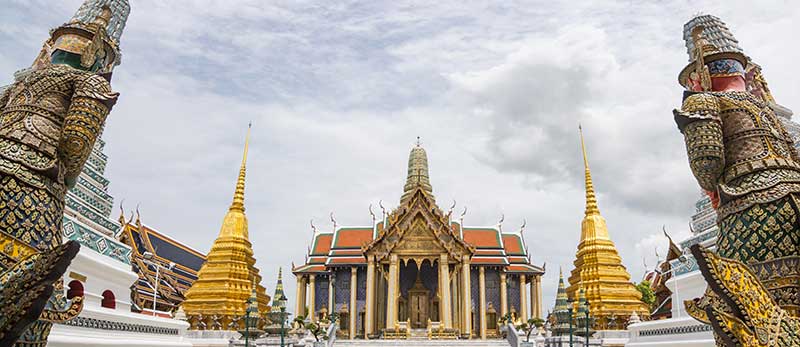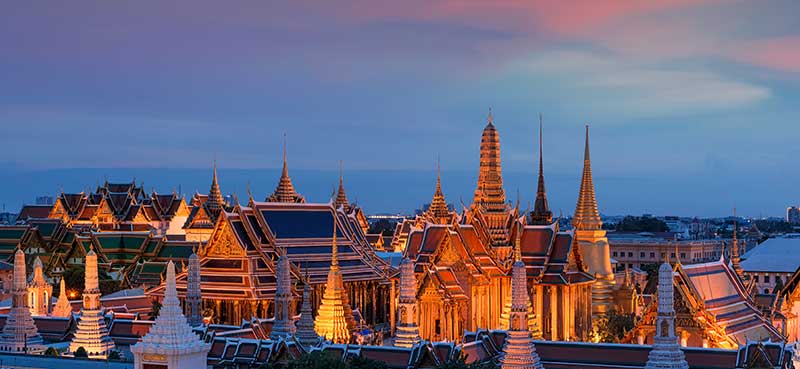One of the most revered and important temples in Thailand is Wat Phra Kaew, also known as the Temple of the Emerald Buddha. This temple was built in the 17th century. It is widely recognized as the holiest temple in Thailand, and its location within the grounds of Bangkok’s Grand Palace makes it one of the most significant sites in the city. The temple is famous for its beautiful architecture, its intricate carvings, and its long and illustrious history. In this blog, we will investigate the remarkable past of Wat Phra Kaew, which is located in Thailand.
Where Did the Buddha with the Emerald Embrace Come From?
The Jadeite statue known as the Emerald Buddha is one of the most revered objects in all of Buddhism. Jadeite is a type of precious stone. The statue’s history is shrouded in mystery, but experts believe it was carved in India approximately 2,000 years ago. Its origins are also unknown. After that, the statue was transported to Sri Lanka, where it remained for a number of centuries before being transported to Thailand in the 15th century.
According to local folklore, the statue was uncovered by a monk who was observing the destruction caused by lightning to a small stupa at a temple in Chiang Rai, which is located in northern Thailand. After conducting his investigation, the monk located the Emerald Buddha that had been concealed within the stupa. The statue was delivered to the King of Chiang Mai, who acknowledged the significance of the object and presented it to the King of Thailand in the year 1784.
Construction of the Wat Pha Kaew Temple
In 1785, not long after the Emerald Buddha was relocated to Bangkok, construction on the current structure of Wat Phra Kaew began. Within the grounds of the recently constructed Grand Palace, which was intended to serve as the official residence of the Kings of Siam, the temple was constructed.
The architecture of the temple was done in the traditional manner of Thailand; it featured multi-tiered roofs, intricate carvings, and brightly colored decorations all over the building. There are murals depicting scenes from the life of the Buddha as well as other significant figures from Thai history adorning the walls of the temple.
The complex of temples also includes a number of other significant buildings, such as the Phra Mondop, a library that houses ancient Buddhist scriptures, and the Phra Si Rattana Chedi, a golden stupa that houses relics of the Buddha. Both of these structures are located within the complex of temples.

The Background of the Wat Phra Kaew Temple
The temple of Wat Phra Kaew has a long and illustrious history in Thailand, and it is the setting for a great number of important events. In the year 1785, King Rama I established Bangkok as the capital of Siam. As the center of his new kingdom, he built the Grand Palace as well as Wat Phra Kaew, which is now known as the Temple of the Emerald Buddha.
The temple was severely damaged by multiple fires in the 19th century, but King Rama VI undertook extensive repairs and renovations to the structure in the early 20th century. Bombings inflicted damage on the temple during World War II, but it was quickly restored to its former glory after the war ended.
Even in the modern era, Wat Phra Kaew is consistently ranked among the most significant and visited tourist destinations in all of Thailand. Each year, the temple is visited by millions of people who come to marvel at the intricate carvings, breathtaking architecture, and, of course, the venerable Emerald Buddha that resides within.
Conclusion
The remarkable Wat Phra Kaew Temple is a site that has been very significant to the development of Thai culture and history. Anyone who is in Bangkok should make it a point to stop by this destination because of its jaw-dropping architecture, intricate carvings, and extensive history. The temple is a demonstration of the indestructible influence that religion and spirituality have had on the development of Thai culture. It is also a testament to the skill and originality of Thai craftsmen.
Wat Phra Kaew is one of the most significant Buddhist temples in Thailand, and it is located in the Grand Palace complex in Bangkok. If you are planning a visit to this sacred site, here are a few things you should know beforehand:
- Dress Code: Visitors to Wat Phra Kaew must dress appropriately to show respect to the temple’s religious significance. Men and women must cover their shoulders and wear pants or long skirts that cover the knees. Sandals are acceptable, but flip-flops and shorts are not allowed.
- Photography: Photography is allowed in most areas of the temple, but there are specific areas where photography is prohibited. Visitors should check for signs or ask for guidance from the temple staff before taking any pictures.
- Entrance Fees: There is an entrance fee for Wat Phra Kaew, and visitors should check the current fee beforehand. Also, be aware that there are many scammers around the area who may try to sell you fake tickets or tours, so make sure to purchase your ticket from an official ticket counter.
- Respect the Sacredness: Wat Phra Kaew is a place of worship for Buddhists, and visitors should respect the sacredness of the site by being quiet and respectful, refraining from touching any religious artifacts, and removing their shoes before entering any buildings.
- Time and Crowds: Wat Phra Kaew is a popular tourist destination, and it can be quite crowded at peak times, so plan your visit accordingly. Also, make sure to allocate plenty of time to explore the site as there are many beautiful buildings, statues, and shrines to see.
By keeping these things in mind, you can make the most of your visit to Wat Phra Kaew and show respect to this significant cultural and religious site.

